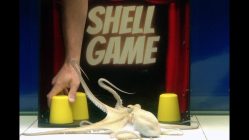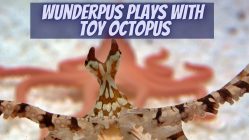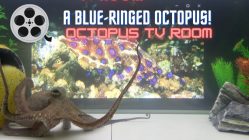
The seven-arm octopus is second only to the giant Pacific octopus in terms of size. It can reach lengths of 12 feet and weigh 170 pounds. By all measures, it is a hefty creature.
Solely for its size alone, it is an interesting octopus to study. However, the more one learns about the characteristics, habits, and behavior of this species, the more unique they become.
Seven Arm Octopus Facts
- Scientific Name : Haliphron Atlanticus
- Common Name: Seven Arm Octopus
- Size: 3,5 m (12 ft)
- Weight: 75kg (170 pounds)
- Lifespan: 2 years
- Found in: Pacific and Atlantic Oceans
- Sub-Order: Incirrina
- Discovered: 1861
- Scientific Name : Haliphron Atlanticus
- Common Name: Seven Arm Octopus
- Size: 3,5 m (12 ft)
- Weight: 75kg (170 pounds)
- Lifespan: 2 years
- Found in: Pacific and Atlantic Oceans
- Sub-Order: Incirrina
- Discovered: 1861
The seven-arm octopus is second only to the giant Pacific octopus in terms of size. It can reach lengths of 12 feet and weigh 170 pounds. By all measures, it is a hefty creature.
—Where Can the Seven-Arm Octopus Be Found?—

The taxonomical name for the seven-arm octopus is Haliphron atlanticus. The “atlanticus” portion of the name came from the fact that the first specimens of these species were found in the Atlantic Ocean.
It was initially believed by marine biologists that this large species of octopus was only to be found in the Atlantic Ocean. In 2002, however, a large specimen of the seven-arm octopus was collected in the waters of the South Pacific.
Also, even more recently, in September 2020, a dead octopus believed to be a seven-arm octopus was washed up on a beach at Ebey’s Landing in Puget Sound. Scientists were surprised with the fact that a specimen of this species was found so far north in the Pacific.
These discoveries required the distribution model for this species to be rethought. It is now established that this species can be found in both the Pacific and Atlantic Oceans. There is also speculation that the seven-arm octopus may also inhabit portions of the Indian Ocean.
Part of the reason why it has taken so much time to properly establish the distribution of the species is due to the fact that this octopus tends to inhabit deep water. Specimens have been caught at depths approaching 3,000 feet.
—Why Does It Only Have Seven Arms?—
As the majority of octopus enthusiasts are aware, octopuses are supposed to have eight arms. This is a characteristic that holds true for all octopus species, including the seven-arm octopus.
The reason that this species obtained its popular name is due to a special trait of the males of the species. This makes it appear as if it only has seven arms when, in fact, it has eight.
—Reproduction and the Eighth Arm—

The seven-arm octopus follows a method of reproduction that is common to most octopus species. The male inserts his sperm packet into an opening in the mantle of the female using one of its arms.
In the case of the seven-arm octopus, the arm used for this purpose — formally known as the “hectocotylus” — is coiled in a sac beneath its right eye. At plain sight to the untrained eye, it would seem as if males only had seven arms. Females of the species have all eight arms of normal length.
Males can mate with multiple females but shortly after they deposit the last of their sperm in a female, their bodies begin to shut down. This essentially seizes the basic biological functions of the octopus. It will die soon thereafter.
The females continue living until they have laid and cared for their eggs to the hatchling stage. During that time the female seven-arm octopus provides physical protection for the eggs and also grooms them to keep them clean and oxygenated.
Soon after the eggs have hatched, the females also die. Sadly this type of reproductive cycle holds true for all octopus species.
—Diet of the Seven-Arm Octopus—

Like most octopus species, the seven-arm octopus is fond of crustaceans and bivalves. Its large size means that it can also take on larger prey, such as fish.
One thing which has been observed about this species’ diet is that it is not too finicky. Unlike other octopus species which tend to display a preference for certain prey, the seven-arm octopus is truly an equal opportunity hunter. As long as it is edible, this octopus will eat it.
—Hunting Style of the Haliphron Atlanticus—
In the wild, this species of octopus has been seen to hunt throughout the day. Most of its daytime hunting, however, falls under the category of “targets of opportunity.” In other words, the seven-arm octopus will catch prey during daylight if prey comes their way. This can be in their burrow or where they may be perched on the ocean floor.
Active hunting by the seven-arm octopus takes place primarily during night. This species has very keen eyesight which is thought to be well adapted for dark conditions. It is no wonder that active hunting takes place under the cover of darkness. This allows the seven-arm octopus to avoid potential predators while also maximizing its stealth against prey.
—Dangers for the Seven-Arm Octopus—

As big as the seven-arm octopus is, it does face danger from predators. These include sharks, seals, swordfish and sperm whales.
The ability for the seven-arm octopus to camouflage itself is superb. It is able to match the color and texture of its surroundings. This is its primary method of evading predators.
When you combine its camouflaging capabilities with its ability to dwell in deep water, the seven-arm octopus has a solid self-preservation plan in place. It comes under the most danger when it is swimming in open water.
This usually happens when it needs to relocate over longer distances or it needs to adjust to a different ocean depth for oxygen absorption reasons.
—The Curious Jellyfish Connection—

In terms of its behavior, the single most curious aspect about the seven-arm octopus is the relationship that it has with jellyfish.
They do not form part of its diet, neither are they predators of this octopus. The relationship is on a completely different level. Observations indicate that the seven-arm octopus actively cares for and protects certain jellyfish.
In turn, the jellyfish — thanks to their poisonous stingers — offer an added layer of defense for this species of octopus. Think of it along the lines of the way that humans care for dogs for companionship and defense.
While more study is needed regarding the symbiotic relationship of jellyfish and the seven-arm octopus, it is a further testament to the high level of intelligence of octopuses. It would be amazing to discover how they process this relationship themselves. Do they see the jellyfish as pets and protectors? Do they actively choose which jellyfish to befriend?
—Large and Unique—
When you take everything that makes the seven-arm octopus stand out you realize how novel of a species it truly is.
From its large size to the shortened eighth arms on the males, to the jellyfish connection — the seven-arm octopus is definitely an octopus species that deserves more thorough study and observation.











